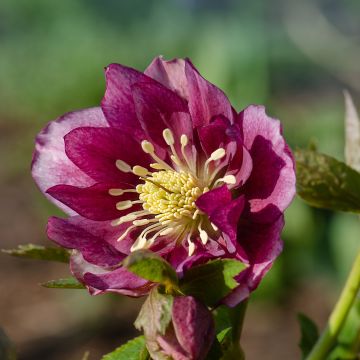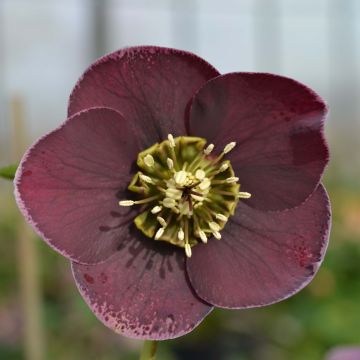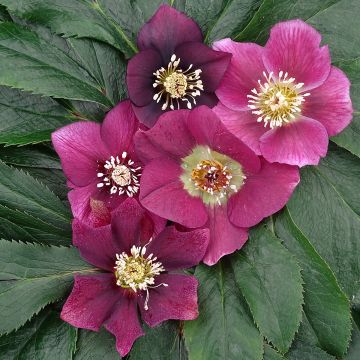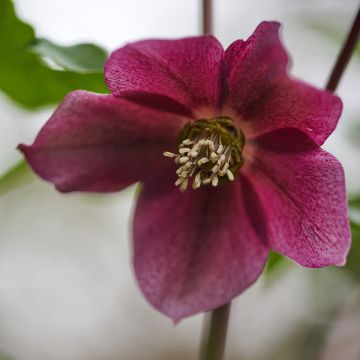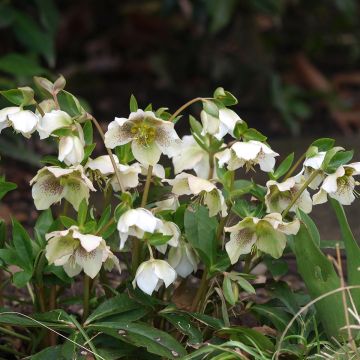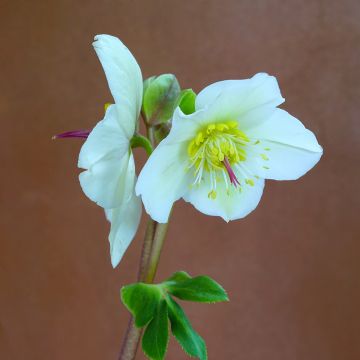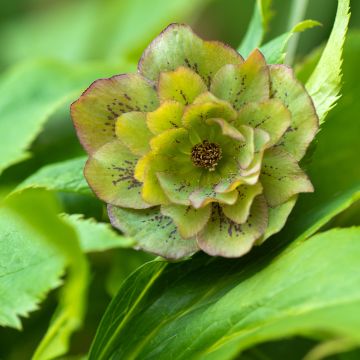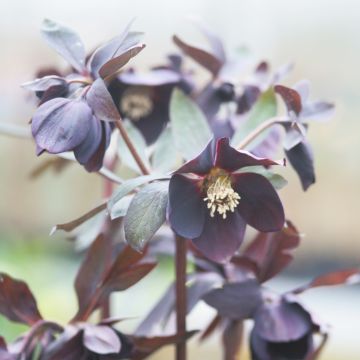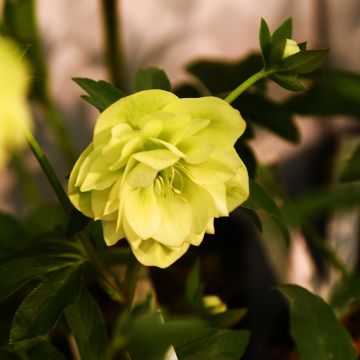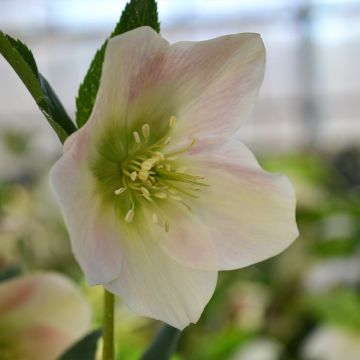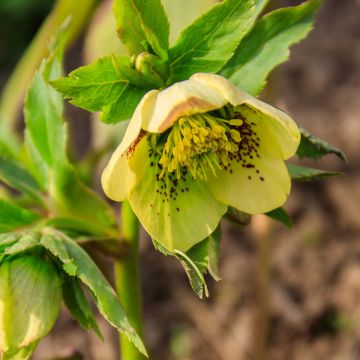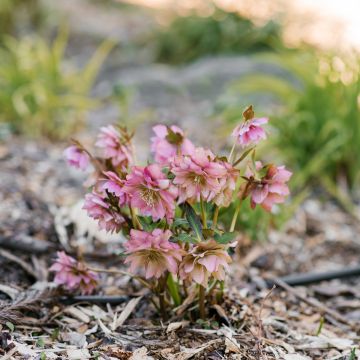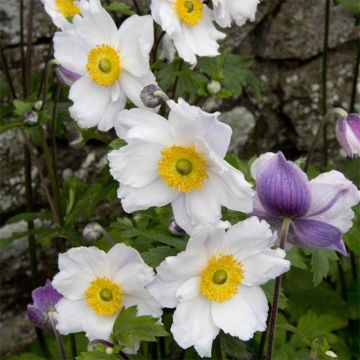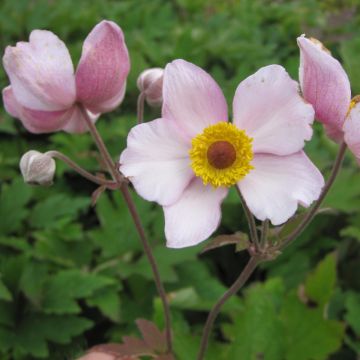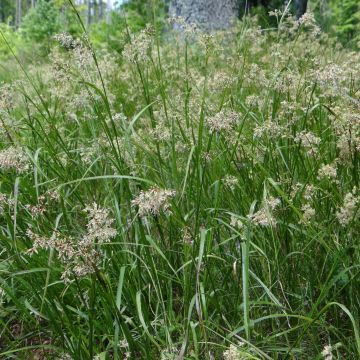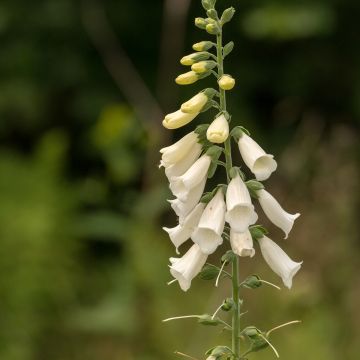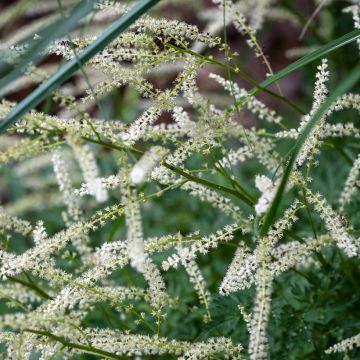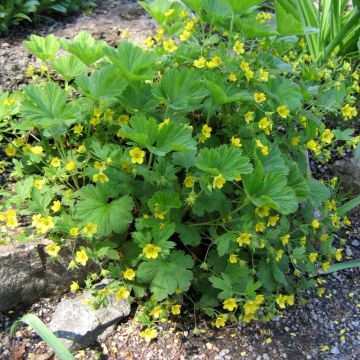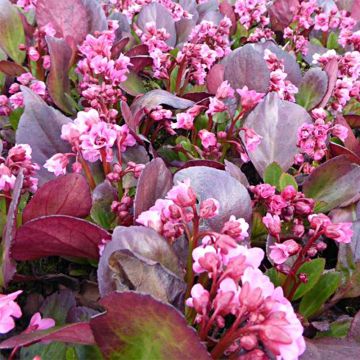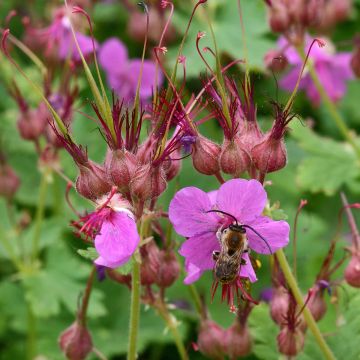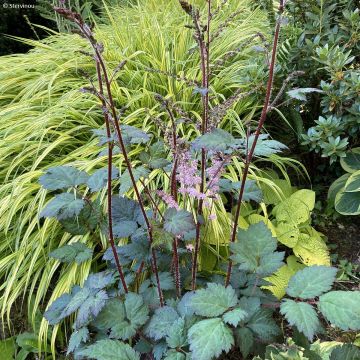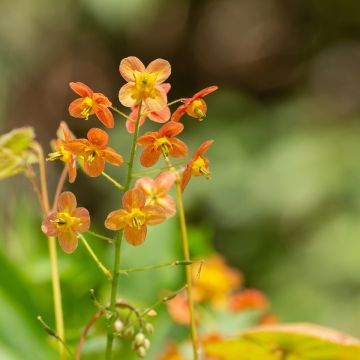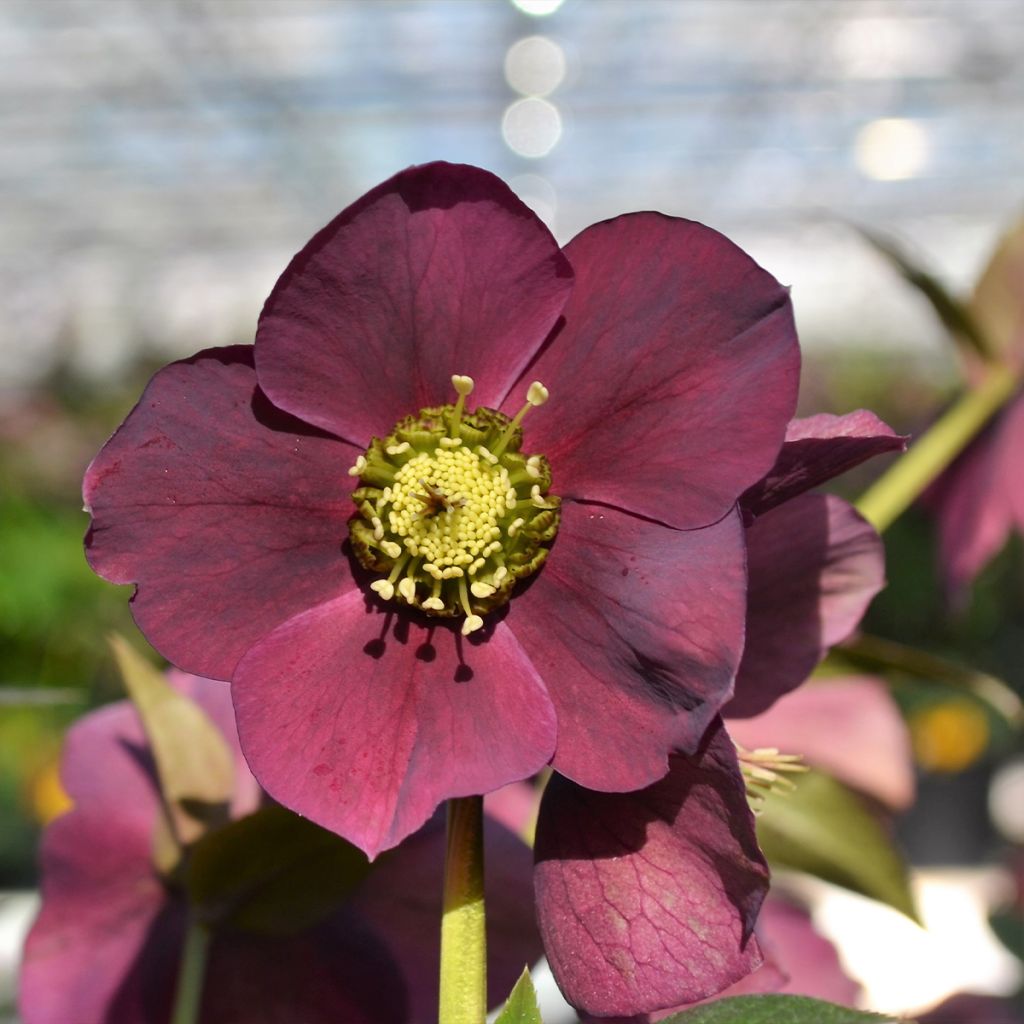

Hellébore ViV Teodora - Helleborus orientalis
Helleborus hybridus ViV Teodora
Helleborus x hybridus ViV Teodora
Lenten Rose, Oriental Hellebore
Why not try an alternative variety in stock?
View all →This plant carries a 12 months recovery warranty
More information
We guarantee the quality of our plants for a full growing cycle, and will replace at our expense any plant that fails to recover under normal climatic and planting conditions.
From €5.90 for pickup delivery and €6.90 for home delivery
Express home delivery from €8.90.
Does this plant fit my garden?
Set up your Plantfit profile →
Description
Teodora is a variety of Oriental Hellebore with enchanting dark winter flowering. Blooming in January and for several weeks, this Lenten Rose produces simple flowers which are dark red and close to purple, enhanced by a boldly contrasting yellow stamen centre. These distinguished cup-shaped flowers bloom prominently above the dark green foliage that serves as a backdrop. The evergreen leaves are highly graphic and finely divided, forming a compact clump that is decorative all year round. This Hellebore is a robust and hardy perennial, easy to grow in all regions. It prefers neutral to limestone soils, but can also tolerate some acidity. It particularly requires damp soil and protection from direct sunlight, and can be successfully grown in containers.
Hellebore (or Christmas Rose) Teodora belongs to the Ranunculaceae family, which includes about sixty genera and approximately 2500 species, mostly herbaceous. The type species Helleborus orientalis is native to Greece, Turkey, and the central and eastern Caucasus. It is a perennial plant that hybridises very easily with other species to produce, through random seedlings, hybrids with diverse colours and forms, so much so that these hybrids are rarely given variety names. They are distinguished by their shape and colour characteristics. Oriental Hellebores are hardy plants that can withstand temperatures as low as -15°C, naturally growing in forests, thickets, and clearings up to 2,000 m (7ft) altitude.
Teodora is a variety distributed by a Belgian company that specializes in the in vitro selection and propagation of Hellebores. This propagation method ensures the perfect transmission of genes and the stability of the species, which are all perfectly identified by their name. Teodora is part of a large collection of hybrids selected for their compactness and abundant flowers. This variety forms a clump that is 35 to 45 cm (14 to 18in) tall and wide, or even wider. This limited growth makes it easy to grow in containers to adorn a balcony or patio. In the garden, it will be decorative all year round with its sturdy habit and highly graphic appearance. Its foliage consists of palmate, slightly toothed basal leaves, which are dark green and glossy. The leaves are evergreen in winter. In reality, they only live for 8 months and are regularly replaced by new leaves. Their highly graphic shape is particularly decorative throughout the year.
Teodora offers winter flowering, starting in the first days of the year and lasting for many weeks. The five imbricate petals that make up the corolla have slightly pointed tips, giving the flower a regular geometric shape. This dark red, almost purple corolla with a wide open shape features yellow stamens that create a marked contrast. These solitary flowers are borne on long stems with small leaves, allowing them to float prominently above the foliage. As with most Hellebore varieties, these corollas are arranged in a vertical plane, or slightly inclined downward, allowing water to slide off like an umbrella, preventing accumulation in the centre that could cause rot. Hellebores do not like to be moved once established, and young shoots sometimes take time to flower. Therefore, be careful to choose their location carefully when planting.
This perennial adapts to neutral to moderately alkaline (limestone) soils, or slightly acidic soils, preferably rich and retaining a certain dampness, although an established plant can withstand dry conditions. However, make sure the soil is well-drained, as Hellebores do not tolerate excessive water in winter. It will thrive under leafy trees, which allow winter sun but protect from intense summer sun. Resistant to temperatures down to approximately -15°C (5°F), it is a relatively easy plant to grow, and will be at home in a partially shaded border or even in a container to create a beautiful winter flowering display.
This Lenten Rose is remarkable for its dark colour, which will harmonise beautifully with other varieties of Hellebores with lighter flowers. To create a decorative shaded border in winter, you can also use coloured bark, such as that of Prunus maackii Amber Beauty. This small deciduous ornamental Cherry tree will shade your Hellebores with its leaves during the growing season. Blooming white in spring, it then bears small black fruits and its leaves turn golden yellow before falling. A four-season tree, its magnificent orange bark is even more beautiful in the rain, which accentuates its original colour. You can also choose the superb Betula albosinensis Fascination, a Birch tree with copper-coloured bark that is equally remarkable as that of Prunus. And to create a backdrop for your Hellebores, Cornus alba Baton Rouge, a Red Twig Dogwood with fascinating coral-red wood, will not fail to impress.
Report an error about the product description
Flowering
Foliage
Plant habit
Safety measures
Botanical data
Helleborus
x hybridus
ViV Teodora
Ranunculaceae
Lenten Rose, Oriental Hellebore
Cultivar or hybrid
ingestion
Cette plante est toxique si elle est ingérée volontairement ou involontairement.
Ne la plantez pas là où de jeunes enfants peuvent évoluer, et lavez-vous les mains après l'avoir manipulée.
Pensez à conserver l'étiquette de la plante, à la photographier ou à noter son nom, afin de faciliter le travail des professionnels de santé.
Davantage d'informations sur https://plantes-risque.info
Other Oriental Hellebore
Planting and care
The Oriental Hellebore Teodora grows in any neutral to moderately calcareous soil, rich, light or clay, in partial or light shade, while being sheltered from cold and strong winds. This perennial should be planted from early autumn to spring. It thrives in deep, well-prepared soil mixed with a quantity of organic matter. To fertilise, use bone meal or another organic fertilizer. Water the plants well after planting and then add a layer of mulch 2 to 5 cm (1 to 2in) thick. Regularly remove faded leaves to improve flowering. Ensure a planting distance of 30 to 40 cm (12 to 16in) between each plant to encourage their development. Hellebores do not tolerate waterlogged ground, as it may cause it to rot.
The roots should not completely dry out in summer. Hellebores can be affected by a fungal disease transmitted by aphids, known as black spot disease. Remove the spotted leaves from evergreen species when the flower buds appear. Remove faded flowers after the seeds have fallen. They can also suffer from grey rot or die from collar rot. This often occurs due to poor growing conditions, in excessively wet situations.
You can also plant this perennial in a pot on a balcony or patio, as its compact habit is well-suited for this. However, choose a sufficiently large pot to allow its root system to develop properly. Very hardy, this Hellebore can withstand negative temperatures down to -15°C (5°F) or even lower.
Planting period
Intended location
Care
This item has not been reviewed yet - be the first to leave a review about it.
Shade-loving perennials
Haven't found what you were looking for?
Hardiness is the lowest winter temperature a plant can endure without suffering serious damage or even dying. However, hardiness is affected by location (a sheltered area, such as a patio), protection (winter cover) and soil type (hardiness is improved by well-drained soil).

Photo Sharing Terms & Conditions
In order to encourage gardeners to interact and share their experiences, Promesse de fleurs offers various media enabling content to be uploaded onto its Site - in particular via the ‘Photo sharing’ module.
The User agrees to refrain from:
- Posting any content that is illegal, prejudicial, insulting, racist, inciteful to hatred, revisionist, contrary to public decency, that infringes on privacy or on the privacy rights of third parties, in particular the publicity rights of persons and goods, intellectual property rights, or the right to privacy.
- Submitting content on behalf of a third party;
- Impersonate the identity of a third party and/or publish any personal information about a third party;
In general, the User undertakes to refrain from any unethical behaviour.
All Content (in particular text, comments, files, images, photos, videos, creative works, etc.), which may be subject to property or intellectual property rights, image or other private rights, shall remain the property of the User, subject to the limited rights granted by the terms of the licence granted by Promesse de fleurs as stated below. Users are at liberty to publish or not to publish such Content on the Site, notably via the ‘Photo Sharing’ facility, and accept that this Content shall be made public and freely accessible, notably on the Internet.
Users further acknowledge, undertake to have ,and guarantee that they hold all necessary rights and permissions to publish such material on the Site, in particular with regard to the legislation in force pertaining to any privacy, property, intellectual property, image, or contractual rights, or rights of any other nature. By publishing such Content on the Site, Users acknowledge accepting full liability as publishers of the Content within the meaning of the law, and grant Promesse de fleurs, free of charge, an inclusive, worldwide licence for the said Content for the entire duration of its publication, including all reproduction, representation, up/downloading, displaying, performing, transmission, and storage rights.
Users also grant permission for their name to be linked to the Content and accept that this link may not always be made available.
By engaging in posting material, Users consent to their Content becoming automatically accessible on the Internet, in particular on other sites and/or blogs and/or web pages of the Promesse de fleurs site, including in particular social pages and the Promesse de fleurs catalogue.
Users may secure the removal of entrusted content free of charge by issuing a simple request via our contact form.
The flowering period indicated on our website applies to countries and regions located in USDA zone 8 (France, the United Kingdom, Ireland, the Netherlands, etc.)
It will vary according to where you live:
- In zones 9 to 10 (Italy, Spain, Greece, etc.), flowering will occur about 2 to 4 weeks earlier.
- In zones 6 to 7 (Germany, Poland, Slovenia, and lower mountainous regions), flowering will be delayed by 2 to 3 weeks.
- In zone 5 (Central Europe, Scandinavia), blooming will be delayed by 3 to 5 weeks.
In temperate climates, pruning of spring-flowering shrubs (forsythia, spireas, etc.) should be done just after flowering.
Pruning of summer-flowering shrubs (Indian Lilac, Perovskia, etc.) can be done in winter or spring.
In cold regions as well as with frost-sensitive plants, avoid pruning too early when severe frosts may still occur.
The planting period indicated on our website applies to countries and regions located in USDA zone 8 (France, United Kingdom, Ireland, Netherlands).
It will vary according to where you live:
- In Mediterranean zones (Marseille, Madrid, Milan, etc.), autumn and winter are the best planting periods.
- In continental zones (Strasbourg, Munich, Vienna, etc.), delay planting by 2 to 3 weeks in spring and bring it forward by 2 to 4 weeks in autumn.
- In mountainous regions (the Alps, Pyrenees, Carpathians, etc.), it is best to plant in late spring (May-June) or late summer (August-September).
The harvesting period indicated on our website applies to countries and regions in USDA zone 8 (France, England, Ireland, the Netherlands).
In colder areas (Scandinavia, Poland, Austria...) fruit and vegetable harvests are likely to be delayed by 3-4 weeks.
In warmer areas (Italy, Spain, Greece, etc.), harvesting will probably take place earlier, depending on weather conditions.
The sowing periods indicated on our website apply to countries and regions within USDA Zone 8 (France, UK, Ireland, Netherlands).
In colder areas (Scandinavia, Poland, Austria...), delay any outdoor sowing by 3-4 weeks, or sow under glass.
In warmer climes (Italy, Spain, Greece, etc.), bring outdoor sowing forward by a few weeks.

































